Michelin Star Meal
- Tudor
- May 16, 2019
- 3 min read
Singapore has many restaurants and “hawker stalls” (food places) around the island. From Newton Food market to Little India, the small city-state is filled with various cuisines from around the world. The stalls they operate in are no bigger than 10m2, enough for a hob, sink, maybe an oven, a few drawers and places to store ingredients, and perhaps two tables. When these incredibly narrow stalls line up together they create a space for food shopping of sorts, where you’d walk around endlessly and aimlessly trying to figure out what to eat. Usually on sale are Indian curries, Chinese Hokkien or Hakka stir-fries and fried-rice foods, Arab or Muslim Halal pitas, or Singaporean specialities such as crayfish. Surprisingly, these stalls, however down-trodden and grotty some seem, display a letter off a grading system. From A to D (or maybe even lower), this centralised-state system ensures that consumers are well informed about restaurants and the foods on display: this place is an A, therefore it is a good quality cuisine, a D, not so much. Malaysia, Australia and New Zealand, to name a few other countries, function on a similar structure.

Some stalls strive to perfect only a limited number of dishes and will structure their routine in a specific pattern, following a strict function for a every action. Consequently, they are quick and efficient at repetitively applying the same action hundreds of times within the lunch hour break in downtown Singapore, where the consumer has thus also a show to enjoy before their food is served. The skill and perfection of some chefs have risen beyond everyday cuisine and have reached heights similar to that of some of the great chefs. Some Hawker Stalls in Singapore are decorated with Michelin Stars for their outstanding dishes.
One such stall we visited is Chuan Kee Boneless Braised Duck in the Yishun Food Market. It serves maybe three or four dishes of braised duck with soy sauce, with either rice or noodles. At only SGD5 (4€) for a big portion, it is probably one of the cheapest Michelin Star-rated meals. The slow-cooked clean duck on fried-rice is really good. However don’t expect any fancy service. The plates and cutlery are centralised and distributed to every hawker stall after they’ve been cleaned. The food market is also located in a remote area of Singapore not easily accessible by tourists. But it’s worth the hassle and it gives you a pretty cool experience of eating food alongside locals who use the market on a daily basis not just for eating, but for social gatherings, entertainment, and shopping.

Newton Food Market and the Little India Food Market are the most famous hawker stalls of Singapore, easily accessible by MRT (Underground) and have a wide variety of foods of all types. The Yishun Food Market is more of what these places are supposed to be for locals. Singapore lacks space for restaurants to develop and grow a business. A small hawker stall dedicated to the perfection of a handful of dishes is the natural choice for people living in a city-state. Organising these small restaurants in food markets is imperative to channel such a vast mass of people coming in to eat, and also to oversee and control the food quality served on the table. Furthermore, it also allows for the owners to focus especially on their dishes, and hence develop the perfect Michelin Star dish, in the narrowest kitchen.
Spatial constraints and cultural competitiveness have not become barriers to the chefs and owners here, but rather catalysers, focusing thus their energy and commitment to do their very best, for this one plate of food, passed down from the first traders in Singapore, centuries ago.




Comments